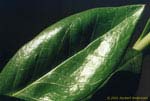Description of Zamioculcas lanceolata |
Description of Zamioculcas lanceolata
extract from
A. PETER, Die Araceae Deutsch-Ostafrikas.
In: Nachrichten von der Gesellschaft der Wissenschaften zu Göttingen aus dem Jahre 1929,
Mathematisch-Physikalische Klasse. Heft 3 (1929), pp. 220-221
Zamioculcas lanceolata A. PETER n. spec. (descriptio a planta viva culta). — S. 209, 211.
Planta acaulis herbacea silvestris, rhizomate crasso turiones breves emittente. Folia basalia ad 60 cm longa valida viridia; petiolus c. 20 cm longus basi (ad 2 cm) incrassatus sursum attenuatus cylindricus, cum laminae rhachide transverse grosse obscure-maculatus, infra laminam nodoso - geniculatus; lamina ad 40 cm longa pinnata, foliolis utrinque c. 8 alternis vel partim ± oppositis lanceolatis basi in petiolum brevissimum (1—2 mm) attenuatis, apice acuminato - acutis, integerrimis attamen subrepando - undulatis crassiusculis epilosis 10—11 × 3.5—4(—5) cm, margine haud punctatis, sponte deciduis basi tubera demum plantam juvenilem gignentibus. Inflorescentia basalis; pedunculus 4—6 cm longus 0.5 cm crassus teres glaber ± recurvatus; spatha subcoriacea c. 7 cm longa 3 cm lata ovata convoluta haud vaginata (marginibus usque ad basin liberis), basi spadicis partem inferiorem arcte subgloboso - amplectens demum reflexa plana tortuosa (nec cymbiformis) margine integerrimo, apice acuminata (nec infra apicem cornuta) acutissima, extus dilute viridis sed punctis nigricantibus frequentissimis conspersa, intus lurida immaculata laevis 5-nervis. Spadix cylindricus 6 cm longus in triente inferiore constrictus densiflorus albidus inferne flores femineos superne masculos media parte constricta steriles omnes contiguos gerens. Flores ![[masculi]](icons/male.gif) spadicis totum apicem 3.5—4 cm longum subclavato - cylindricum rotundato - obtusum occupantes, perigonio tetramero, tepalis 2 exterioribus squamiformibus, interioribus clavatis longitudinaliter complicatis, omnibus apice truncato-rotundatis, staminibus 4 brevibus, pistillo sterili claviformi tepala aequante; flores steriles similes staminibus carentes pistillo rudimentario clavato praediti; florum spadicis totum apicem 3.5—4 cm longum subclavato - cylindricum rotundato - obtusum occupantes, perigonio tetramero, tepalis 2 exterioribus squamiformibus, interioribus clavatis longitudinaliter complicatis, omnibus apice truncato-rotundatis, staminibus 4 brevibus, pistillo sterili claviformi tepala aequante; flores steriles similes staminibus carentes pistillo rudimentario clavato praediti; florum ![[femineorum]](icons/female.gif) tepala exteriora conspicue squamiformia interiora clavata, omnia apice truncata, pistillo ovato, stilo brevissimo, stigmate apice transverse - elliptico ceraceo tepalis paullo breviore. — Speciei Z. Loddigesii arcte affinis, a qua foliolis angustioribus tenuioribusque, spatha usque ad basin fissa superne explanata cuspidato - acutissima differt. — Specimina authentica: P 31194. Planta in hortum botanicum Gottingensem viva introducta m. Julio 1928 floruit. tepala exteriora conspicue squamiformia interiora clavata, omnia apice truncata, pistillo ovato, stilo brevissimo, stigmate apice transverse - elliptico ceraceo tepalis paullo breviore. — Speciei Z. Loddigesii arcte affinis, a qua foliolis angustioribus tenuioribusque, spatha usque ad basin fissa superne explanata cuspidato - acutissima differt. — Specimina authentica: P 31194. Planta in hortum botanicum Gottingensem viva introducta m. Julio 1928 floruit. |
Translation (first draft, incomplete):
Zamioculcas lanceolata A.PETER n. spec. (description after living cultivated plant). — S. 209, 211.
Stemless, herbaceous forest plant that develops short sprouts from a thick rhizome. Basal leaves up to 60 cm long, glossy green [? valida viridia]; petiole approx. 20 cm long, at the base (up to 2 cm) thick(ened), upwards [? sursum] attenuated (? narrow) cylindrical(ly), with large, dark-maculated [laminae] across the r(h)achis, below the lamina nodose-geniculated; lamina up to 40 cm long, pinnate, with lanceolate leaves [utrinque] c. 8 alternate or partly ± opposite, [verschmälert-attenuatis] at the base into a very short petiol(ul)e (1-2 mm), the apex acuminate-acute, entire edges [attamen] [subrepando]-undulate with [crassiusculis epilosis]10-11 x 3.5-4(-5) cm, the margin not punctated, [sponte deciduis basi tubera demum plantam juvenilem gignentibus.]. Inflorescence from the basis [? basalis], peduncle (stem) 4-6 cm long and 0,5 cm thick, [teres glaber] ± bent down (backwards ?), spathe [subcoriacea], ca. 7 cm long and 3 cm wide, ovate, rolled [? convoluta] but not sheathed (the margins free to the basis), base close (tight) to the lower part of the spadix, subglobose-[amplectens -stengelumfassend?], later bent backwards, [plana tortuosa] (and not cymbiform) with entire margin, the apex acuminate and pointed sharply (and not with a "horn" [appendix] below the top), the outside light green but covered with many blackish (dark) spots, the inner side yellow(ish), immaculate, slightly 5-veined. The cylindrical spadix 6 cm long, divided in three densely flowered whitish regions, the lower part bearing female flowers, the upper male and the center sterile, all [contiguos]. Male flowers covering the whole, 3,5—4 cm long, subclavate-cylindrical rotundate-obtusate apex of the spadix, with a tetramerous perigone, the 2 outer tepals squamiform, the club-shaped inner ones folded lengthwise, all with a truncate-rounded apex, 4 short stamina, a sterile club-shaped pistil resembling the tepals [annotation: ?]; sterile flowers similar, bearing stamina that are surmounted by a rudimentary club-shaped pistil; outer tepals of female flowers conspicuously squamiform, inner ones club-shaped, all with truncate apex, the pistil ovate, stylus very short, the stigmate apex transverse-elliptical, the ceraceous tepals little shorter. — Closely related to the species Z. Loddigesii, from which it differs by the narrower and thinner leaflets and the cuspidate-sharply pointed spathe [that is] split until to the basis, as explained above. — Type specimens: [Herbarium A. Peter no.:] P 31194. The plant that had been brought to the Göttingen Botanical Garden alive has flowered in the month of July, 1928.
(Annotation: it's been some 20 years since I've translated from Latin (to german) for the last time;
this is the first time I try to translate Latin into English. Any corrections most welcome.) |
A. PETER's article:
full (gif images)
transcript (pdf 156 KB)
of all Zamioculcas related passages


transcript (html)
of PETER's habitat records for
Z. lanceolata and
Z. Loddigesii
 |


